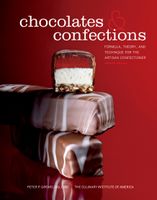Label
All
0
Clear all filters
🍝 Enjoy the cooking of Italy and save 25% on ckbk Membership 🇮🇹
Technique Theory: Butter Ganache
Appears in
By Peter Greweling and Culinary Institute of America
Published 2007
Like cream ganache, butter ganache may be piped or spread into a slab. The method for making up the ganache differs slightly—especially in the temperature of the butter and the amount of mixing—depending on which of these two methods is used.
- MIX SOFT BUTTER WITH SWEETENER. The butter for a piped butter ganache should not be softened as much as the butter for a slabbed butter ganache. When piping, it is best to warm the butter to approximately 20°C/68°F; for slabbing, the temperature should be nearly 30°C/86°F. Depending on the intended use of the butter ganache, the butter and sweetener are also mixed differently. If a butter ganache is to be piped, the two ingredients should be creamed together well in order to aerate the mixture. This is usually accomplished using a mixer, with a paddle or whip attachment run at medium speed. The light texture this method creates helps the piped pieces to hold their shape and provides a light mouthfeel to the finished confection. If the butter ganache is to be slabbed, it is preferable to mix the butter and sweetener together gently, just combining them but not aerating the mixture. This is best accomplished by hand, unless the batch is very large and hand mixing is impractical. A slabbed butter ganache does not require a light texture to maintain its shape as it sets, so aeration is unnecessary. If aerated, a slabbed ganache will not cut cleanly, resulting in irregular shapes, lack of uniformity, corners that are not square, and sides that crumble when they are cut.
Using chocolate discs as bases, pipe butter ganache confections, such as these Rainiers, to a decorative peak, then finish as desired (see step 4 of the technique). - ADD MELTED, TEMPERED CHOCOLATE TO THE BUTTER-SWEETENER BLEND. The chocolate used to make butter ganache must be tempered and near its optimal working temperature before being added to the butter-sweetener mixture. Just as when using chocolate alone, using tempered chocolate ensures that the butter ganache will set quickly, without the formation of bloom and, most important, with a smooth, firm, homogeneous texture. Using untempered chocolate in butter ganache results in a product that takes a long time to set, is insufficiently firm upon setting, and develops large fat crystals over time, resulting in a grainy mouthfeel in the finished product. The chocolate must be near its optimal working temperature for two reasons: so that it does not solidify as soon as it is combined with the butter and so that the butter ganache remains at a workable consistency for a period of time after mixing so that it can be piped or spread. Even when making a moderately large batch, it is advisable to add the chocolate into the butter by hand; a mixer paddle throws chocolate around the inside of the bowl, creating chocolate chips in the ganache. A mixer should be used for only very large batches of butter ganache, and even then, the chocolate must be added carefully and the bowl scraped well to ensure good distribution of the chocolate.
- MIX IN LIQUID FLAVORINGS. Liquid flavoring is part of the dispersed phase of the butter ganache emulsion and therefore should be added in a steady stream while the mixture is stirred. This ensures that the liquid is properly dispersed throughout the continuous fat phase. The added liquid should be neither too cold nor too hot, but at around room temperature (20°C/68°F), so as not to crystallize the fat—which it would do if too cold—or soften the fat and perhaps remove the temper—which it would do if too hot.
- PIPE OR SLAB AS DESIRED. Once mixed, the butter ganache may be piped or slabbed as desired. If slabbing, simply spread the ganache into a frame, allow it to crystallize, bottom-coat it, cut it, and then dip the pieces. When piping individual pieces of butter ganache, pipe directly onto chocolate discs, which serve as bases when the piped pieces are dipped. Piping onto bases effectively seals the bottom of each piece to prevent exposure to oxygen, to block moisture migration, and to make the pieces easier to handle with a dipping fork. Such bases serve the same function as precoating but eliminate the need to bottom-coat each piece prior to dipping. As a rule, tabling butter ganache is not necessary because the chocolate used to make it is tempered and therefore contains stable fat crystals. However, if a butter ganache is too soft to pipe after mixing, tabling to prompt crystallization quickly brings it to piping consistency. This step is optional, and it is only used when the butter ganache is excessively soft after makeup.
Become a Premium Member to access this page
Unlimited, ad-free access to hundreds of the world’s best cookbooks
Over 150,000 recipes with thousands more added every month
Recommended by leading chefs and food writers
Powerful search filters to match your tastes
Create collections and add reviews or private notes to any recipe
Swipe to browse each cookbook from cover-to-cover
Manage your subscription via the My Membership page
Best value
Part of
Advertisement
Related Recipes
-
-
-
-
Related Reference
-
-
-
-
Advertisement
The licensor does not allow printing of this title





